Business Law Report: English Legal System and Business Operations
VerifiedAdded on 2020/10/22
|10
|3303
|395
Report
AI Summary
This comprehensive business law report delves into the English legal system, outlining its nature, sources, and the role of government in law-making. It illustrates the potential impact of various laws, including contract law, competition law, data protection, and consumer protection, on business operations. The report examines the formation of different types of business organizations, such as sole traders, partnerships, and registered companies, including their legal structures, management, and the application of company law. Furthermore, it provides legal solutions for different case scenarios and explains alternative dispute resolution methods, offering a thorough understanding of business law principles and their practical implications. This report is a valuable resource for students seeking to understand the legal framework governing businesses.
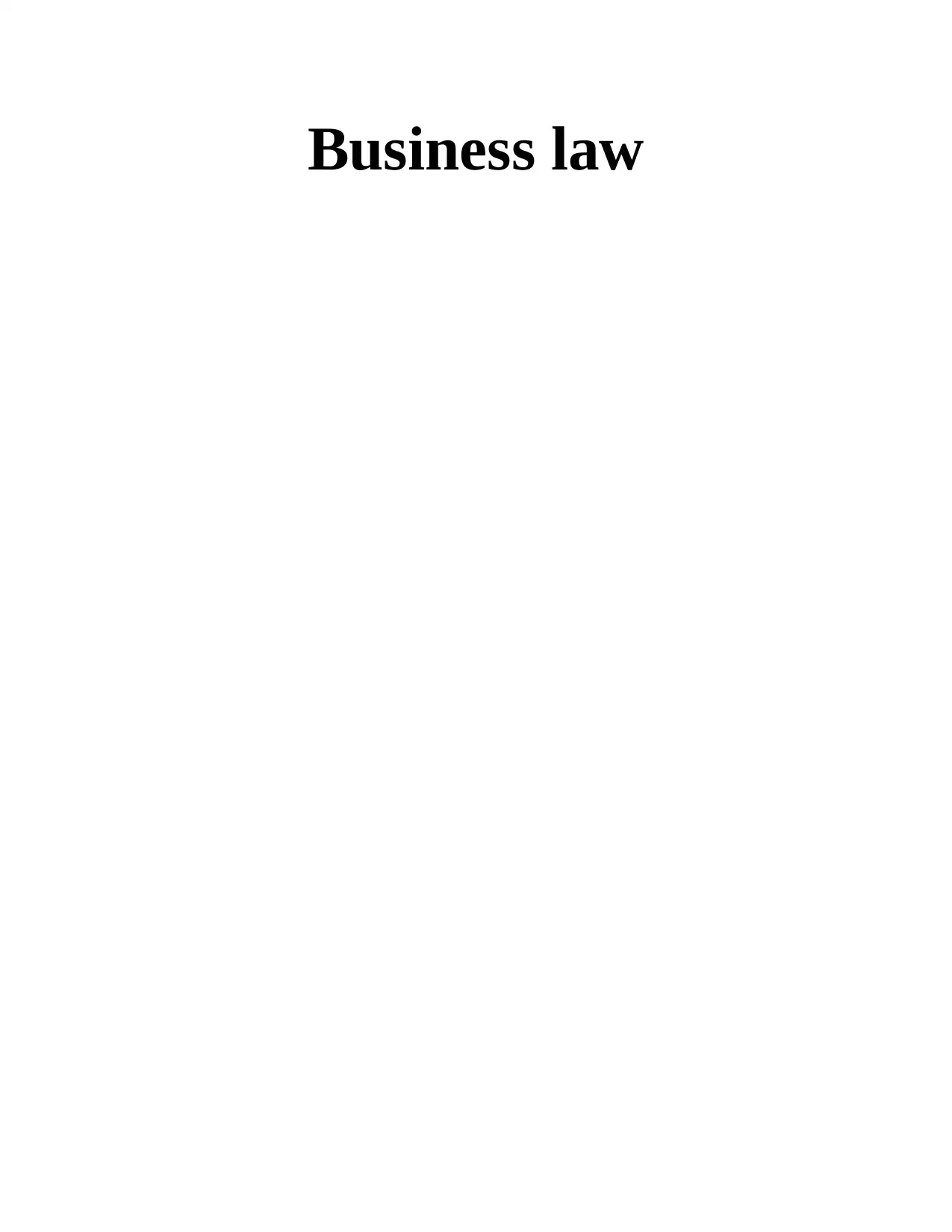
Business law
Paraphrase This Document
Need a fresh take? Get an instant paraphrase of this document with our AI Paraphraser
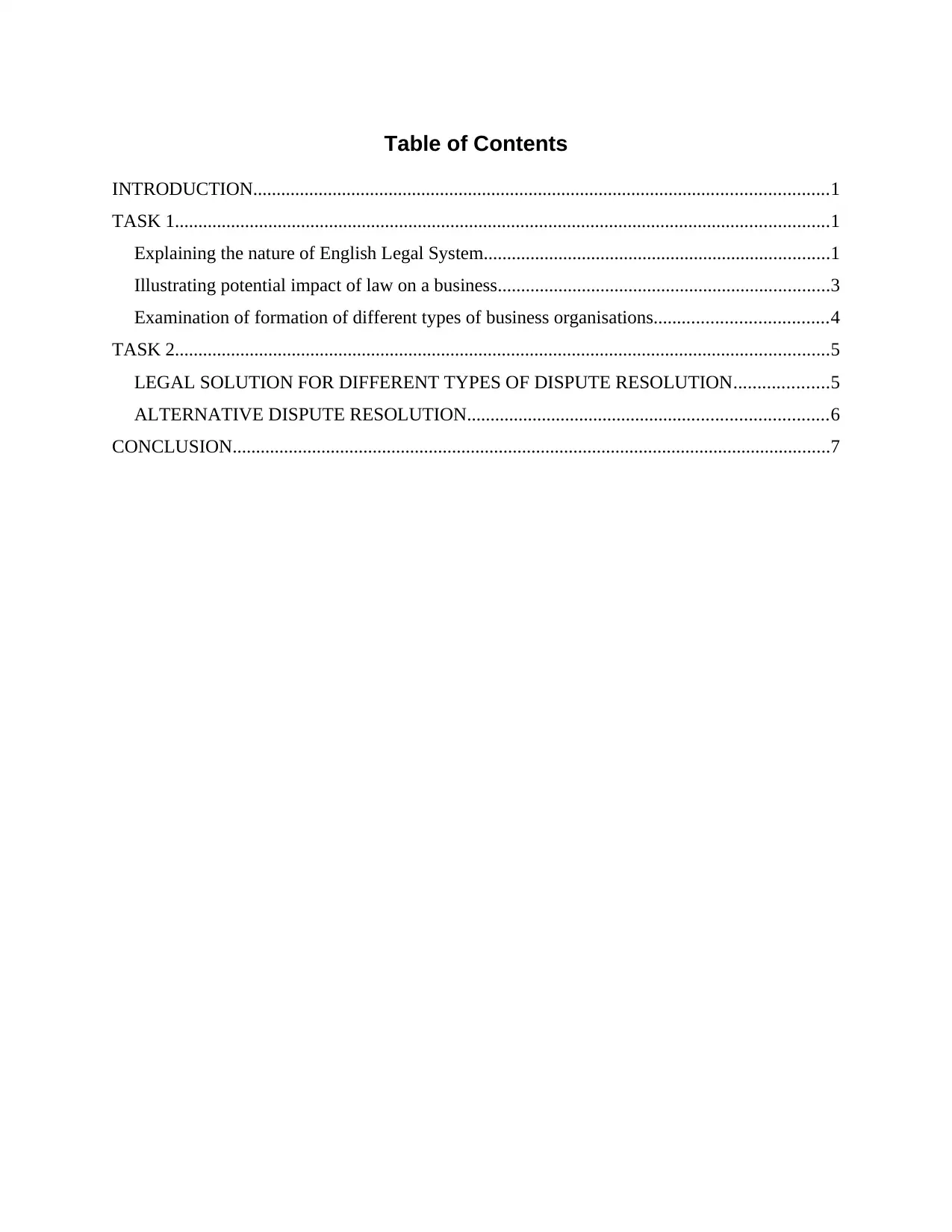
Table of Contents
INTRODUCTION...........................................................................................................................1
TASK 1............................................................................................................................................1
Explaining the nature of English Legal System..........................................................................1
Illustrating potential impact of law on a business.......................................................................3
Examination of formation of different types of business organisations.....................................4
TASK 2............................................................................................................................................5
LEGAL SOLUTION FOR DIFFERENT TYPES OF DISPUTE RESOLUTION....................5
ALTERNATIVE DISPUTE RESOLUTION.............................................................................6
CONCLUSION................................................................................................................................7
INTRODUCTION...........................................................................................................................1
TASK 1............................................................................................................................................1
Explaining the nature of English Legal System..........................................................................1
Illustrating potential impact of law on a business.......................................................................3
Examination of formation of different types of business organisations.....................................4
TASK 2............................................................................................................................................5
LEGAL SOLUTION FOR DIFFERENT TYPES OF DISPUTE RESOLUTION....................5
ALTERNATIVE DISPUTE RESOLUTION.............................................................................6
CONCLUSION................................................................................................................................7
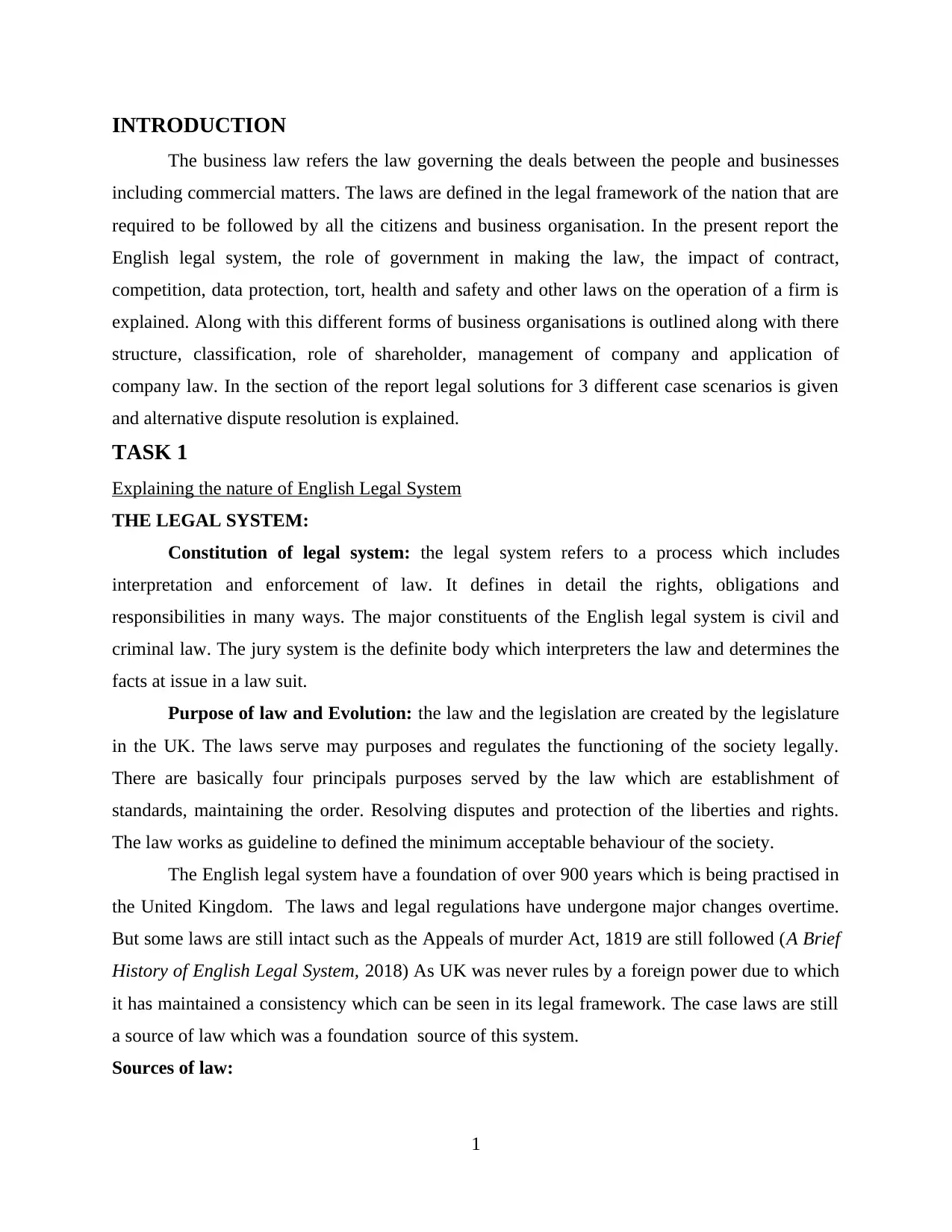
INTRODUCTION
The business law refers the law governing the deals between the people and businesses
including commercial matters. The laws are defined in the legal framework of the nation that are
required to be followed by all the citizens and business organisation. In the present report the
English legal system, the role of government in making the law, the impact of contract,
competition, data protection, tort, health and safety and other laws on the operation of a firm is
explained. Along with this different forms of business organisations is outlined along with there
structure, classification, role of shareholder, management of company and application of
company law. In the section of the report legal solutions for 3 different case scenarios is given
and alternative dispute resolution is explained.
TASK 1
Explaining the nature of English Legal System
THE LEGAL SYSTEM:
Constitution of legal system: the legal system refers to a process which includes
interpretation and enforcement of law. It defines in detail the rights, obligations and
responsibilities in many ways. The major constituents of the English legal system is civil and
criminal law. The jury system is the definite body which interpreters the law and determines the
facts at issue in a law suit.
Purpose of law and Evolution: the law and the legislation are created by the legislature
in the UK. The laws serve may purposes and regulates the functioning of the society legally.
There are basically four principals purposes served by the law which are establishment of
standards, maintaining the order. Resolving disputes and protection of the liberties and rights.
The law works as guideline to defined the minimum acceptable behaviour of the society.
The English legal system have a foundation of over 900 years which is being practised in
the United Kingdom. The laws and legal regulations have undergone major changes overtime.
But some laws are still intact such as the Appeals of murder Act, 1819 are still followed (A Brief
History of English Legal System, 2018) As UK was never rules by a foreign power due to which
it has maintained a consistency which can be seen in its legal framework. The case laws are still
a source of law which was a foundation source of this system.
Sources of law:
1
The business law refers the law governing the deals between the people and businesses
including commercial matters. The laws are defined in the legal framework of the nation that are
required to be followed by all the citizens and business organisation. In the present report the
English legal system, the role of government in making the law, the impact of contract,
competition, data protection, tort, health and safety and other laws on the operation of a firm is
explained. Along with this different forms of business organisations is outlined along with there
structure, classification, role of shareholder, management of company and application of
company law. In the section of the report legal solutions for 3 different case scenarios is given
and alternative dispute resolution is explained.
TASK 1
Explaining the nature of English Legal System
THE LEGAL SYSTEM:
Constitution of legal system: the legal system refers to a process which includes
interpretation and enforcement of law. It defines in detail the rights, obligations and
responsibilities in many ways. The major constituents of the English legal system is civil and
criminal law. The jury system is the definite body which interpreters the law and determines the
facts at issue in a law suit.
Purpose of law and Evolution: the law and the legislation are created by the legislature
in the UK. The laws serve may purposes and regulates the functioning of the society legally.
There are basically four principals purposes served by the law which are establishment of
standards, maintaining the order. Resolving disputes and protection of the liberties and rights.
The law works as guideline to defined the minimum acceptable behaviour of the society.
The English legal system have a foundation of over 900 years which is being practised in
the United Kingdom. The laws and legal regulations have undergone major changes overtime.
But some laws are still intact such as the Appeals of murder Act, 1819 are still followed (A Brief
History of English Legal System, 2018) As UK was never rules by a foreign power due to which
it has maintained a consistency which can be seen in its legal framework. The case laws are still
a source of law which was a foundation source of this system.
Sources of law:
1
⊘ This is a preview!⊘
Do you want full access?
Subscribe today to unlock all pages.

Trusted by 1+ million students worldwide
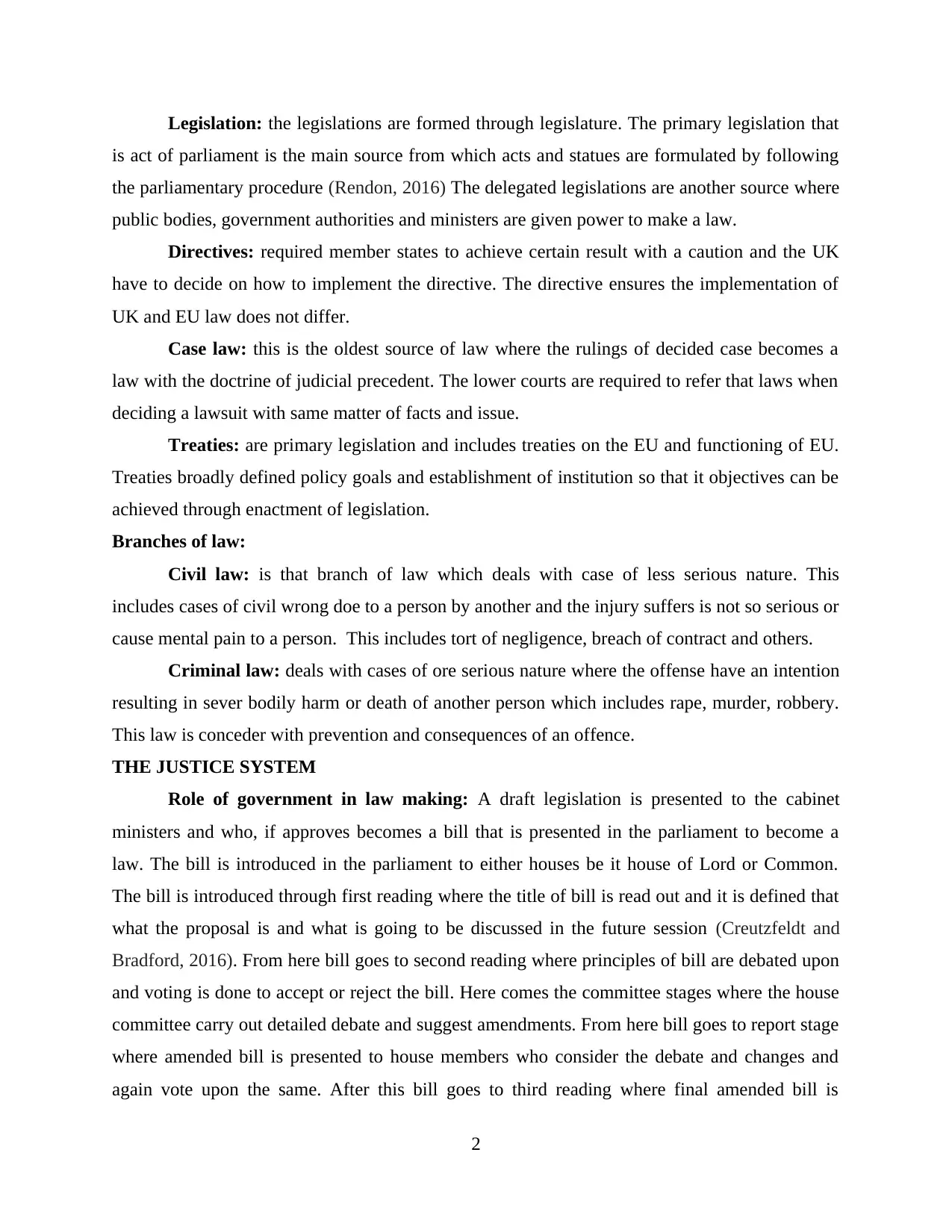
Legislation: the legislations are formed through legislature. The primary legislation that
is act of parliament is the main source from which acts and statues are formulated by following
the parliamentary procedure (Rendon, 2016) The delegated legislations are another source where
public bodies, government authorities and ministers are given power to make a law.
Directives: required member states to achieve certain result with a caution and the UK
have to decide on how to implement the directive. The directive ensures the implementation of
UK and EU law does not differ.
Case law: this is the oldest source of law where the rulings of decided case becomes a
law with the doctrine of judicial precedent. The lower courts are required to refer that laws when
deciding a lawsuit with same matter of facts and issue.
Treaties: are primary legislation and includes treaties on the EU and functioning of EU.
Treaties broadly defined policy goals and establishment of institution so that it objectives can be
achieved through enactment of legislation.
Branches of law:
Civil law: is that branch of law which deals with case of less serious nature. This
includes cases of civil wrong doe to a person by another and the injury suffers is not so serious or
cause mental pain to a person. This includes tort of negligence, breach of contract and others.
Criminal law: deals with cases of ore serious nature where the offense have an intention
resulting in sever bodily harm or death of another person which includes rape, murder, robbery.
This law is conceder with prevention and consequences of an offence.
THE JUSTICE SYSTEM
Role of government in law making: A draft legislation is presented to the cabinet
ministers and who, if approves becomes a bill that is presented in the parliament to become a
law. The bill is introduced in the parliament to either houses be it house of Lord or Common.
The bill is introduced through first reading where the title of bill is read out and it is defined that
what the proposal is and what is going to be discussed in the future session (Creutzfeldt and
Bradford, 2016). From here bill goes to second reading where principles of bill are debated upon
and voting is done to accept or reject the bill. Here comes the committee stages where the house
committee carry out detailed debate and suggest amendments. From here bill goes to report stage
where amended bill is presented to house members who consider the debate and changes and
again vote upon the same. After this bill goes to third reading where final amended bill is
2
is act of parliament is the main source from which acts and statues are formulated by following
the parliamentary procedure (Rendon, 2016) The delegated legislations are another source where
public bodies, government authorities and ministers are given power to make a law.
Directives: required member states to achieve certain result with a caution and the UK
have to decide on how to implement the directive. The directive ensures the implementation of
UK and EU law does not differ.
Case law: this is the oldest source of law where the rulings of decided case becomes a
law with the doctrine of judicial precedent. The lower courts are required to refer that laws when
deciding a lawsuit with same matter of facts and issue.
Treaties: are primary legislation and includes treaties on the EU and functioning of EU.
Treaties broadly defined policy goals and establishment of institution so that it objectives can be
achieved through enactment of legislation.
Branches of law:
Civil law: is that branch of law which deals with case of less serious nature. This
includes cases of civil wrong doe to a person by another and the injury suffers is not so serious or
cause mental pain to a person. This includes tort of negligence, breach of contract and others.
Criminal law: deals with cases of ore serious nature where the offense have an intention
resulting in sever bodily harm or death of another person which includes rape, murder, robbery.
This law is conceder with prevention and consequences of an offence.
THE JUSTICE SYSTEM
Role of government in law making: A draft legislation is presented to the cabinet
ministers and who, if approves becomes a bill that is presented in the parliament to become a
law. The bill is introduced in the parliament to either houses be it house of Lord or Common.
The bill is introduced through first reading where the title of bill is read out and it is defined that
what the proposal is and what is going to be discussed in the future session (Creutzfeldt and
Bradford, 2016). From here bill goes to second reading where principles of bill are debated upon
and voting is done to accept or reject the bill. Here comes the committee stages where the house
committee carry out detailed debate and suggest amendments. From here bill goes to report stage
where amended bill is presented to house members who consider the debate and changes and
again vote upon the same. After this bill goes to third reading where final amended bill is
2
Paraphrase This Document
Need a fresh take? Get an instant paraphrase of this document with our AI Paraphraser
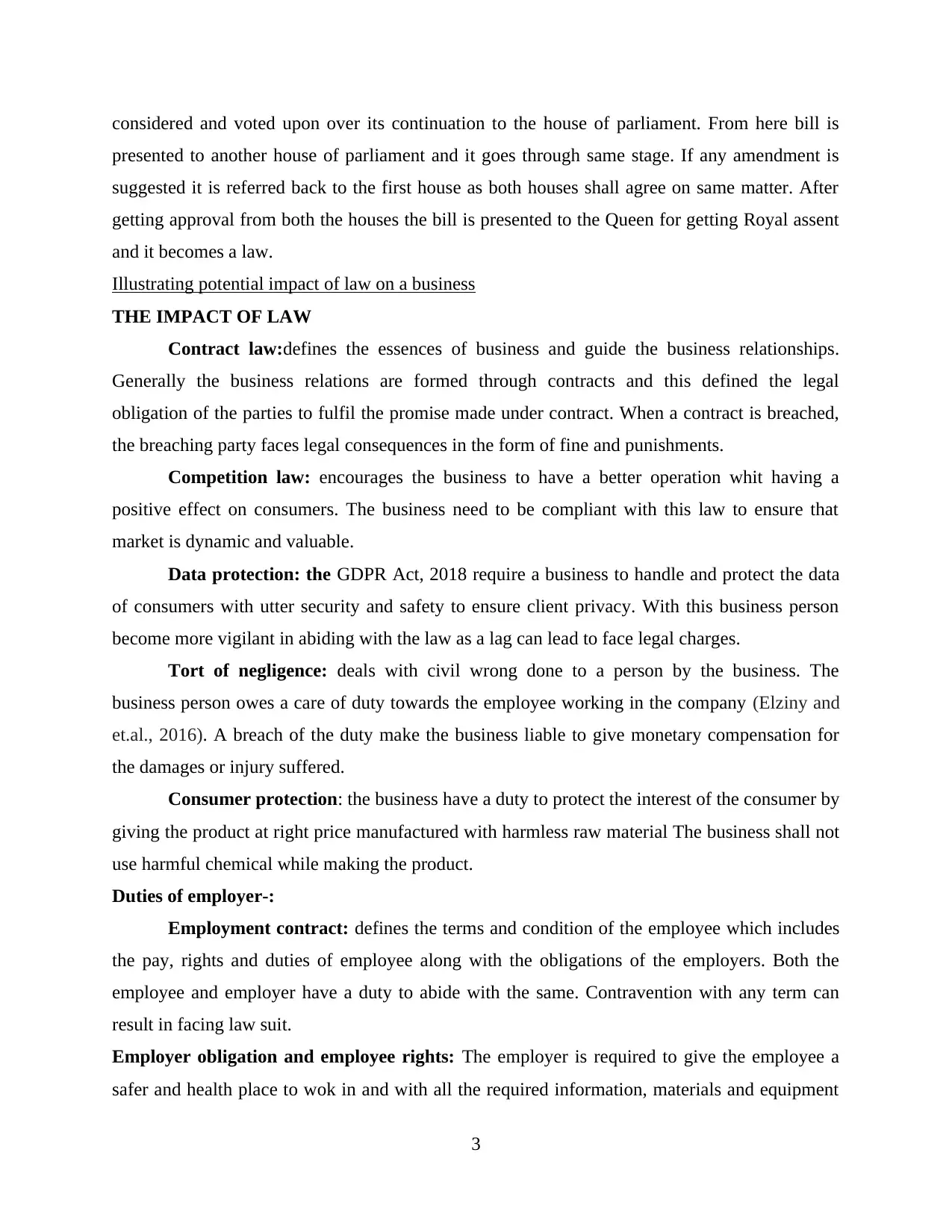
considered and voted upon over its continuation to the house of parliament. From here bill is
presented to another house of parliament and it goes through same stage. If any amendment is
suggested it is referred back to the first house as both houses shall agree on same matter. After
getting approval from both the houses the bill is presented to the Queen for getting Royal assent
and it becomes a law.
Illustrating potential impact of law on a business
THE IMPACT OF LAW
Contract law:defines the essences of business and guide the business relationships.
Generally the business relations are formed through contracts and this defined the legal
obligation of the parties to fulfil the promise made under contract. When a contract is breached,
the breaching party faces legal consequences in the form of fine and punishments.
Competition law: encourages the business to have a better operation whit having a
positive effect on consumers. The business need to be compliant with this law to ensure that
market is dynamic and valuable.
Data protection: the GDPR Act, 2018 require a business to handle and protect the data
of consumers with utter security and safety to ensure client privacy. With this business person
become more vigilant in abiding with the law as a lag can lead to face legal charges.
Tort of negligence: deals with civil wrong done to a person by the business. The
business person owes a care of duty towards the employee working in the company (Elziny and
et.al., 2016). A breach of the duty make the business liable to give monetary compensation for
the damages or injury suffered.
Consumer protection: the business have a duty to protect the interest of the consumer by
giving the product at right price manufactured with harmless raw material The business shall not
use harmful chemical while making the product.
Duties of employer-:
Employment contract: defines the terms and condition of the employee which includes
the pay, rights and duties of employee along with the obligations of the employers. Both the
employee and employer have a duty to abide with the same. Contravention with any term can
result in facing law suit.
Employer obligation and employee rights: The employer is required to give the employee a
safer and health place to wok in and with all the required information, materials and equipment
3
presented to another house of parliament and it goes through same stage. If any amendment is
suggested it is referred back to the first house as both houses shall agree on same matter. After
getting approval from both the houses the bill is presented to the Queen for getting Royal assent
and it becomes a law.
Illustrating potential impact of law on a business
THE IMPACT OF LAW
Contract law:defines the essences of business and guide the business relationships.
Generally the business relations are formed through contracts and this defined the legal
obligation of the parties to fulfil the promise made under contract. When a contract is breached,
the breaching party faces legal consequences in the form of fine and punishments.
Competition law: encourages the business to have a better operation whit having a
positive effect on consumers. The business need to be compliant with this law to ensure that
market is dynamic and valuable.
Data protection: the GDPR Act, 2018 require a business to handle and protect the data
of consumers with utter security and safety to ensure client privacy. With this business person
become more vigilant in abiding with the law as a lag can lead to face legal charges.
Tort of negligence: deals with civil wrong done to a person by the business. The
business person owes a care of duty towards the employee working in the company (Elziny and
et.al., 2016). A breach of the duty make the business liable to give monetary compensation for
the damages or injury suffered.
Consumer protection: the business have a duty to protect the interest of the consumer by
giving the product at right price manufactured with harmless raw material The business shall not
use harmful chemical while making the product.
Duties of employer-:
Employment contract: defines the terms and condition of the employee which includes
the pay, rights and duties of employee along with the obligations of the employers. Both the
employee and employer have a duty to abide with the same. Contravention with any term can
result in facing law suit.
Employer obligation and employee rights: The employer is required to give the employee a
safer and health place to wok in and with all the required information, materials and equipment
3
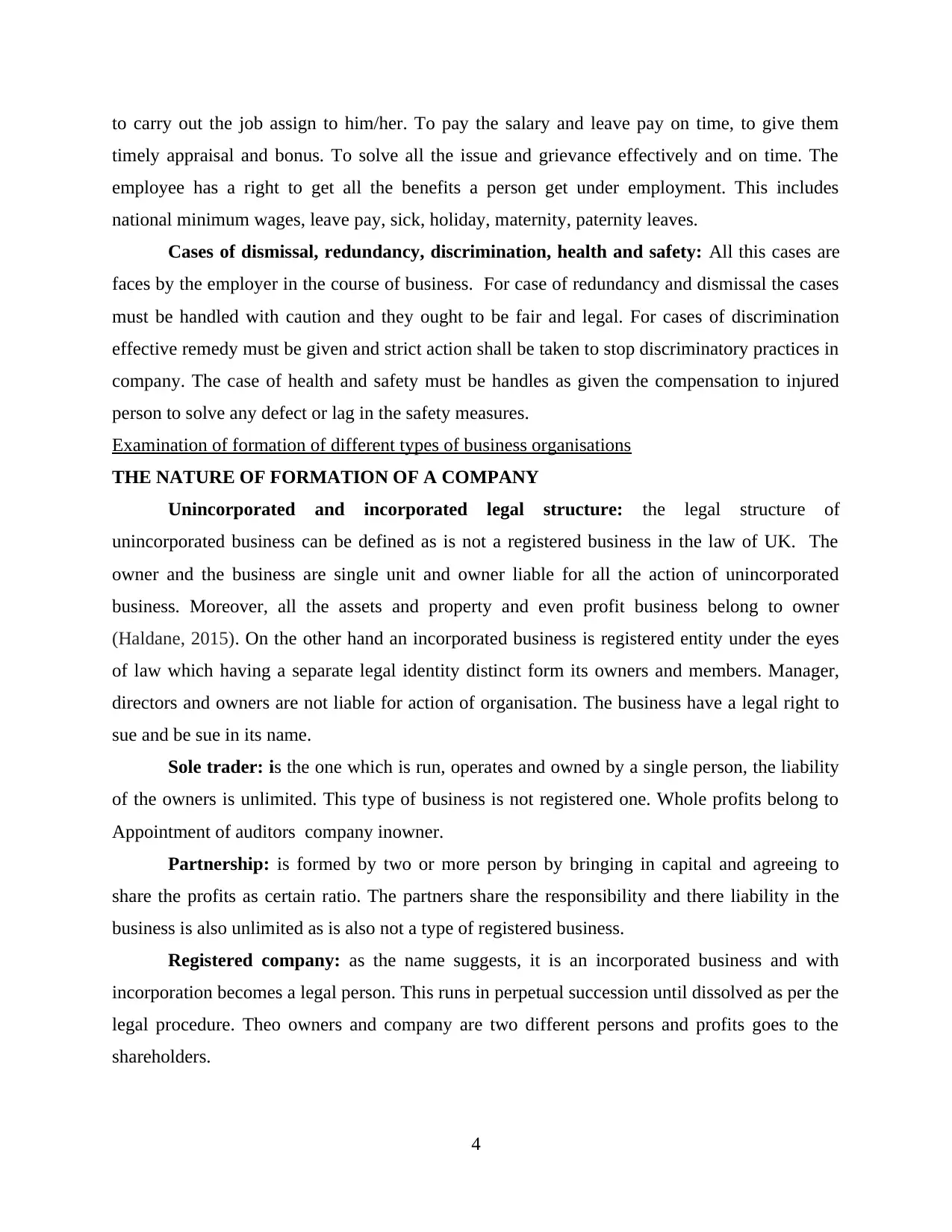
to carry out the job assign to him/her. To pay the salary and leave pay on time, to give them
timely appraisal and bonus. To solve all the issue and grievance effectively and on time. The
employee has a right to get all the benefits a person get under employment. This includes
national minimum wages, leave pay, sick, holiday, maternity, paternity leaves.
Cases of dismissal, redundancy, discrimination, health and safety: All this cases are
faces by the employer in the course of business. For case of redundancy and dismissal the cases
must be handled with caution and they ought to be fair and legal. For cases of discrimination
effective remedy must be given and strict action shall be taken to stop discriminatory practices in
company. The case of health and safety must be handles as given the compensation to injured
person to solve any defect or lag in the safety measures.
Examination of formation of different types of business organisations
THE NATURE OF FORMATION OF A COMPANY
Unincorporated and incorporated legal structure: the legal structure of
unincorporated business can be defined as is not a registered business in the law of UK. The
owner and the business are single unit and owner liable for all the action of unincorporated
business. Moreover, all the assets and property and even profit business belong to owner
(Haldane, 2015). On the other hand an incorporated business is registered entity under the eyes
of law which having a separate legal identity distinct form its owners and members. Manager,
directors and owners are not liable for action of organisation. The business have a legal right to
sue and be sue in its name.
Sole trader: is the one which is run, operates and owned by a single person, the liability
of the owners is unlimited. This type of business is not registered one. Whole profits belong to
Appointment of auditors company inowner.
Partnership: is formed by two or more person by bringing in capital and agreeing to
share the profits as certain ratio. The partners share the responsibility and there liability in the
business is also unlimited as is also not a type of registered business.
Registered company: as the name suggests, it is an incorporated business and with
incorporation becomes a legal person. This runs in perpetual succession until dissolved as per the
legal procedure. Theo owners and company are two different persons and profits goes to the
shareholders.
4
timely appraisal and bonus. To solve all the issue and grievance effectively and on time. The
employee has a right to get all the benefits a person get under employment. This includes
national minimum wages, leave pay, sick, holiday, maternity, paternity leaves.
Cases of dismissal, redundancy, discrimination, health and safety: All this cases are
faces by the employer in the course of business. For case of redundancy and dismissal the cases
must be handled with caution and they ought to be fair and legal. For cases of discrimination
effective remedy must be given and strict action shall be taken to stop discriminatory practices in
company. The case of health and safety must be handles as given the compensation to injured
person to solve any defect or lag in the safety measures.
Examination of formation of different types of business organisations
THE NATURE OF FORMATION OF A COMPANY
Unincorporated and incorporated legal structure: the legal structure of
unincorporated business can be defined as is not a registered business in the law of UK. The
owner and the business are single unit and owner liable for all the action of unincorporated
business. Moreover, all the assets and property and even profit business belong to owner
(Haldane, 2015). On the other hand an incorporated business is registered entity under the eyes
of law which having a separate legal identity distinct form its owners and members. Manager,
directors and owners are not liable for action of organisation. The business have a legal right to
sue and be sue in its name.
Sole trader: is the one which is run, operates and owned by a single person, the liability
of the owners is unlimited. This type of business is not registered one. Whole profits belong to
Appointment of auditors company inowner.
Partnership: is formed by two or more person by bringing in capital and agreeing to
share the profits as certain ratio. The partners share the responsibility and there liability in the
business is also unlimited as is also not a type of registered business.
Registered company: as the name suggests, it is an incorporated business and with
incorporation becomes a legal person. This runs in perpetual succession until dissolved as per the
legal procedure. Theo owners and company are two different persons and profits goes to the
shareholders.
4
⊘ This is a preview!⊘
Do you want full access?
Subscribe today to unlock all pages.

Trusted by 1+ million students worldwide
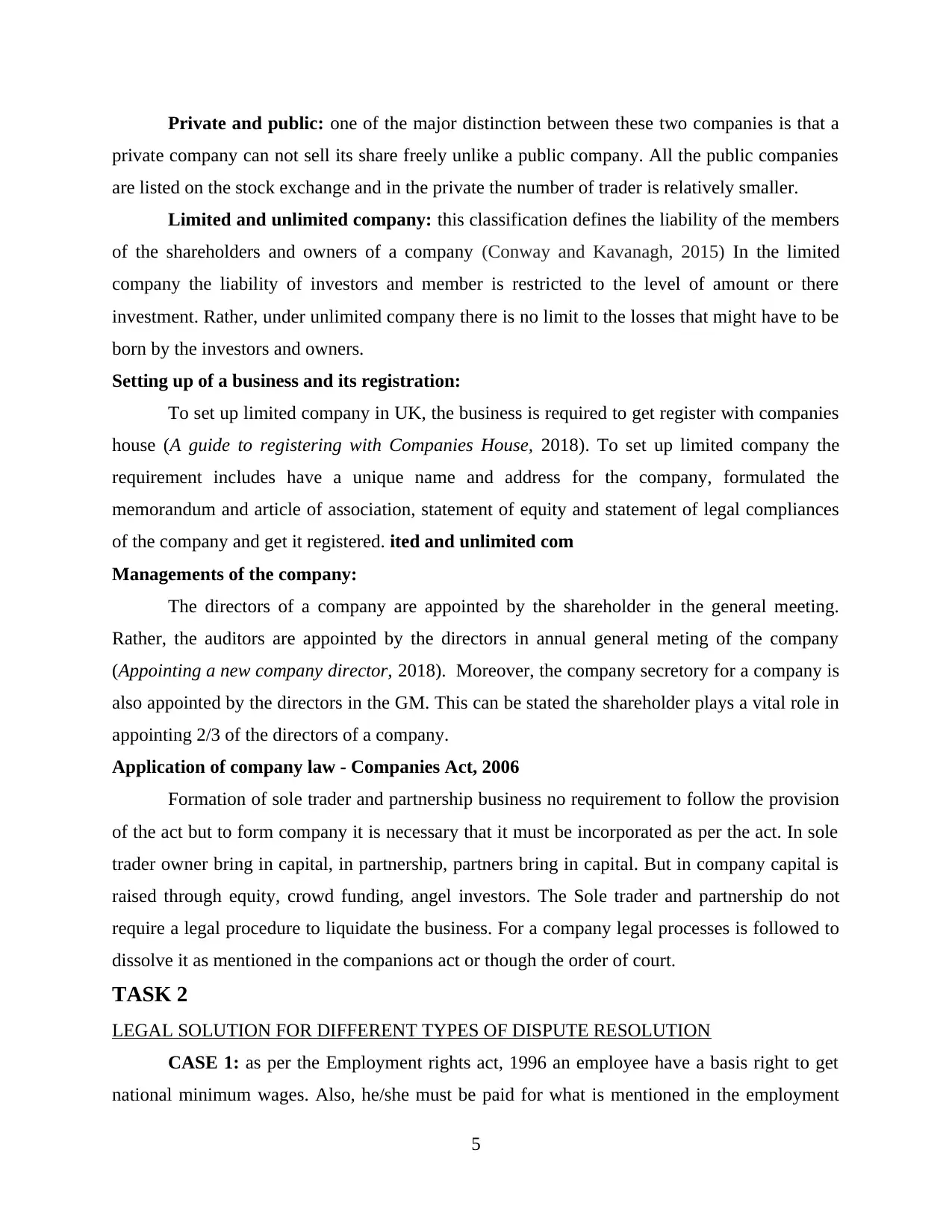
Private and public: one of the major distinction between these two companies is that a
private company can not sell its share freely unlike a public company. All the public companies
are listed on the stock exchange and in the private the number of trader is relatively smaller.
Limited and unlimited company: this classification defines the liability of the members
of the shareholders and owners of a company (Conway and Kavanagh, 2015) In the limited
company the liability of investors and member is restricted to the level of amount or there
investment. Rather, under unlimited company there is no limit to the losses that might have to be
born by the investors and owners.
Setting up of a business and its registration:
To set up limited company in UK, the business is required to get register with companies
house (A guide to registering with Companies House, 2018). To set up limited company the
requirement includes have a unique name and address for the company, formulated the
memorandum and article of association, statement of equity and statement of legal compliances
of the company and get it registered. ited and unlimited com
Managements of the company:
The directors of a company are appointed by the shareholder in the general meeting.
Rather, the auditors are appointed by the directors in annual general meting of the company
(Appointing a new company director, 2018). Moreover, the company secretory for a company is
also appointed by the directors in the GM. This can be stated the shareholder plays a vital role in
appointing 2/3 of the directors of a company.
Application of company law - Companies Act, 2006
Formation of sole trader and partnership business no requirement to follow the provision
of the act but to form company it is necessary that it must be incorporated as per the act. In sole
trader owner bring in capital, in partnership, partners bring in capital. But in company capital is
raised through equity, crowd funding, angel investors. The Sole trader and partnership do not
require a legal procedure to liquidate the business. For a company legal processes is followed to
dissolve it as mentioned in the companions act or though the order of court.
TASK 2
LEGAL SOLUTION FOR DIFFERENT TYPES OF DISPUTE RESOLUTION
CASE 1: as per the Employment rights act, 1996 an employee have a basis right to get
national minimum wages. Also, he/she must be paid for what is mentioned in the employment
5
private company can not sell its share freely unlike a public company. All the public companies
are listed on the stock exchange and in the private the number of trader is relatively smaller.
Limited and unlimited company: this classification defines the liability of the members
of the shareholders and owners of a company (Conway and Kavanagh, 2015) In the limited
company the liability of investors and member is restricted to the level of amount or there
investment. Rather, under unlimited company there is no limit to the losses that might have to be
born by the investors and owners.
Setting up of a business and its registration:
To set up limited company in UK, the business is required to get register with companies
house (A guide to registering with Companies House, 2018). To set up limited company the
requirement includes have a unique name and address for the company, formulated the
memorandum and article of association, statement of equity and statement of legal compliances
of the company and get it registered. ited and unlimited com
Managements of the company:
The directors of a company are appointed by the shareholder in the general meeting.
Rather, the auditors are appointed by the directors in annual general meting of the company
(Appointing a new company director, 2018). Moreover, the company secretory for a company is
also appointed by the directors in the GM. This can be stated the shareholder plays a vital role in
appointing 2/3 of the directors of a company.
Application of company law - Companies Act, 2006
Formation of sole trader and partnership business no requirement to follow the provision
of the act but to form company it is necessary that it must be incorporated as per the act. In sole
trader owner bring in capital, in partnership, partners bring in capital. But in company capital is
raised through equity, crowd funding, angel investors. The Sole trader and partnership do not
require a legal procedure to liquidate the business. For a company legal processes is followed to
dissolve it as mentioned in the companions act or though the order of court.
TASK 2
LEGAL SOLUTION FOR DIFFERENT TYPES OF DISPUTE RESOLUTION
CASE 1: as per the Employment rights act, 1996 an employee have a basis right to get
national minimum wages. Also, he/she must be paid for what is mentioned in the employment
5
Paraphrase This Document
Need a fresh take? Get an instant paraphrase of this document with our AI Paraphraser
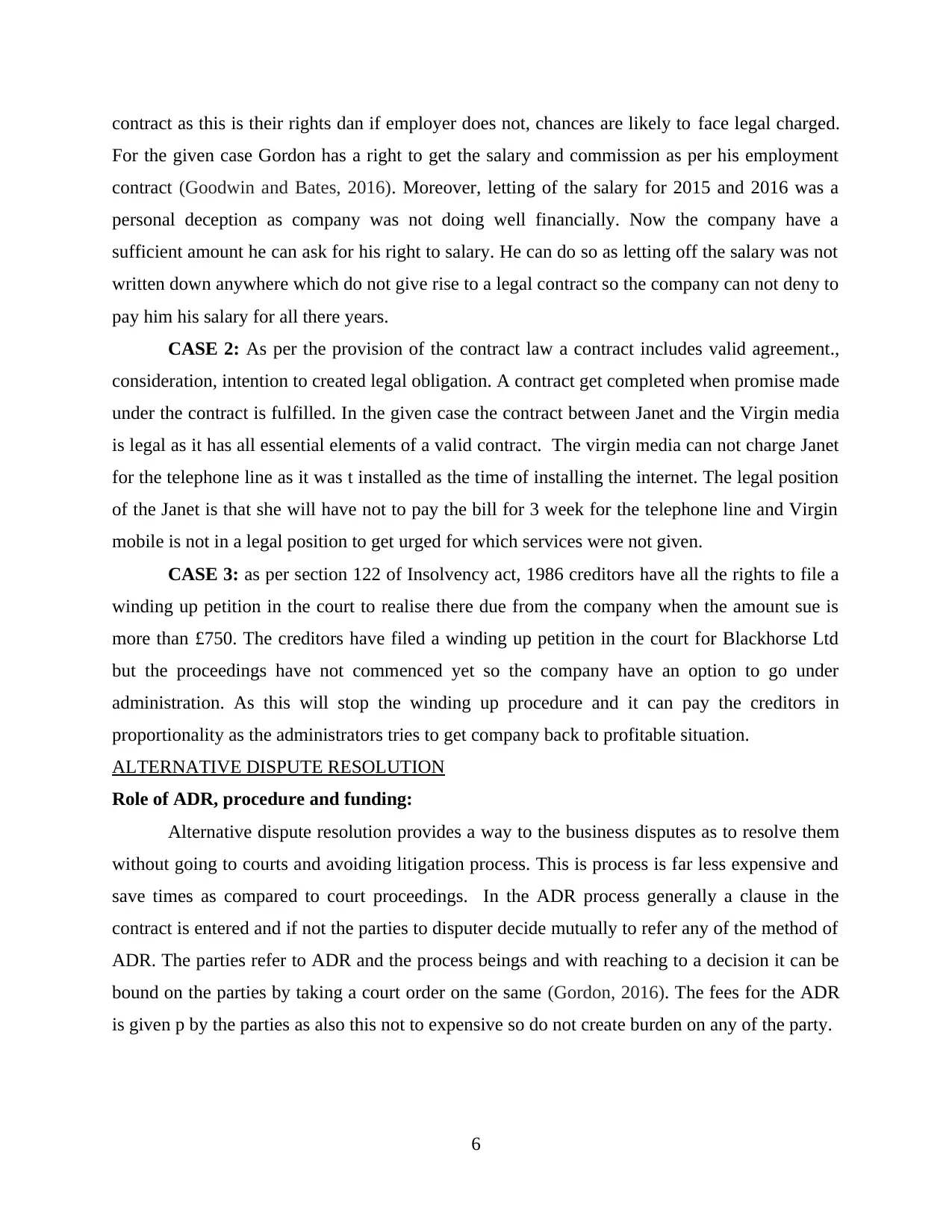
contract as this is their rights dan if employer does not, chances are likely to face legal charged.
For the given case Gordon has a right to get the salary and commission as per his employment
contract (Goodwin and Bates, 2016). Moreover, letting of the salary for 2015 and 2016 was a
personal deception as company was not doing well financially. Now the company have a
sufficient amount he can ask for his right to salary. He can do so as letting off the salary was not
written down anywhere which do not give rise to a legal contract so the company can not deny to
pay him his salary for all there years.
CASE 2: As per the provision of the contract law a contract includes valid agreement.,
consideration, intention to created legal obligation. A contract get completed when promise made
under the contract is fulfilled. In the given case the contract between Janet and the Virgin media
is legal as it has all essential elements of a valid contract. The virgin media can not charge Janet
for the telephone line as it was t installed as the time of installing the internet. The legal position
of the Janet is that she will have not to pay the bill for 3 week for the telephone line and Virgin
mobile is not in a legal position to get urged for which services were not given.
CASE 3: as per section 122 of Insolvency act, 1986 creditors have all the rights to file a
winding up petition in the court to realise there due from the company when the amount sue is
more than £750. The creditors have filed a winding up petition in the court for Blackhorse Ltd
but the proceedings have not commenced yet so the company have an option to go under
administration. As this will stop the winding up procedure and it can pay the creditors in
proportionality as the administrators tries to get company back to profitable situation.
ALTERNATIVE DISPUTE RESOLUTION
Role of ADR, procedure and funding:
Alternative dispute resolution provides a way to the business disputes as to resolve them
without going to courts and avoiding litigation process. This is process is far less expensive and
save times as compared to court proceedings. In the ADR process generally a clause in the
contract is entered and if not the parties to disputer decide mutually to refer any of the method of
ADR. The parties refer to ADR and the process beings and with reaching to a decision it can be
bound on the parties by taking a court order on the same (Gordon, 2016). The fees for the ADR
is given p by the parties as also this not to expensive so do not create burden on any of the party.
6
For the given case Gordon has a right to get the salary and commission as per his employment
contract (Goodwin and Bates, 2016). Moreover, letting of the salary for 2015 and 2016 was a
personal deception as company was not doing well financially. Now the company have a
sufficient amount he can ask for his right to salary. He can do so as letting off the salary was not
written down anywhere which do not give rise to a legal contract so the company can not deny to
pay him his salary for all there years.
CASE 2: As per the provision of the contract law a contract includes valid agreement.,
consideration, intention to created legal obligation. A contract get completed when promise made
under the contract is fulfilled. In the given case the contract between Janet and the Virgin media
is legal as it has all essential elements of a valid contract. The virgin media can not charge Janet
for the telephone line as it was t installed as the time of installing the internet. The legal position
of the Janet is that she will have not to pay the bill for 3 week for the telephone line and Virgin
mobile is not in a legal position to get urged for which services were not given.
CASE 3: as per section 122 of Insolvency act, 1986 creditors have all the rights to file a
winding up petition in the court to realise there due from the company when the amount sue is
more than £750. The creditors have filed a winding up petition in the court for Blackhorse Ltd
but the proceedings have not commenced yet so the company have an option to go under
administration. As this will stop the winding up procedure and it can pay the creditors in
proportionality as the administrators tries to get company back to profitable situation.
ALTERNATIVE DISPUTE RESOLUTION
Role of ADR, procedure and funding:
Alternative dispute resolution provides a way to the business disputes as to resolve them
without going to courts and avoiding litigation process. This is process is far less expensive and
save times as compared to court proceedings. In the ADR process generally a clause in the
contract is entered and if not the parties to disputer decide mutually to refer any of the method of
ADR. The parties refer to ADR and the process beings and with reaching to a decision it can be
bound on the parties by taking a court order on the same (Gordon, 2016). The fees for the ADR
is given p by the parties as also this not to expensive so do not create burden on any of the party.
6
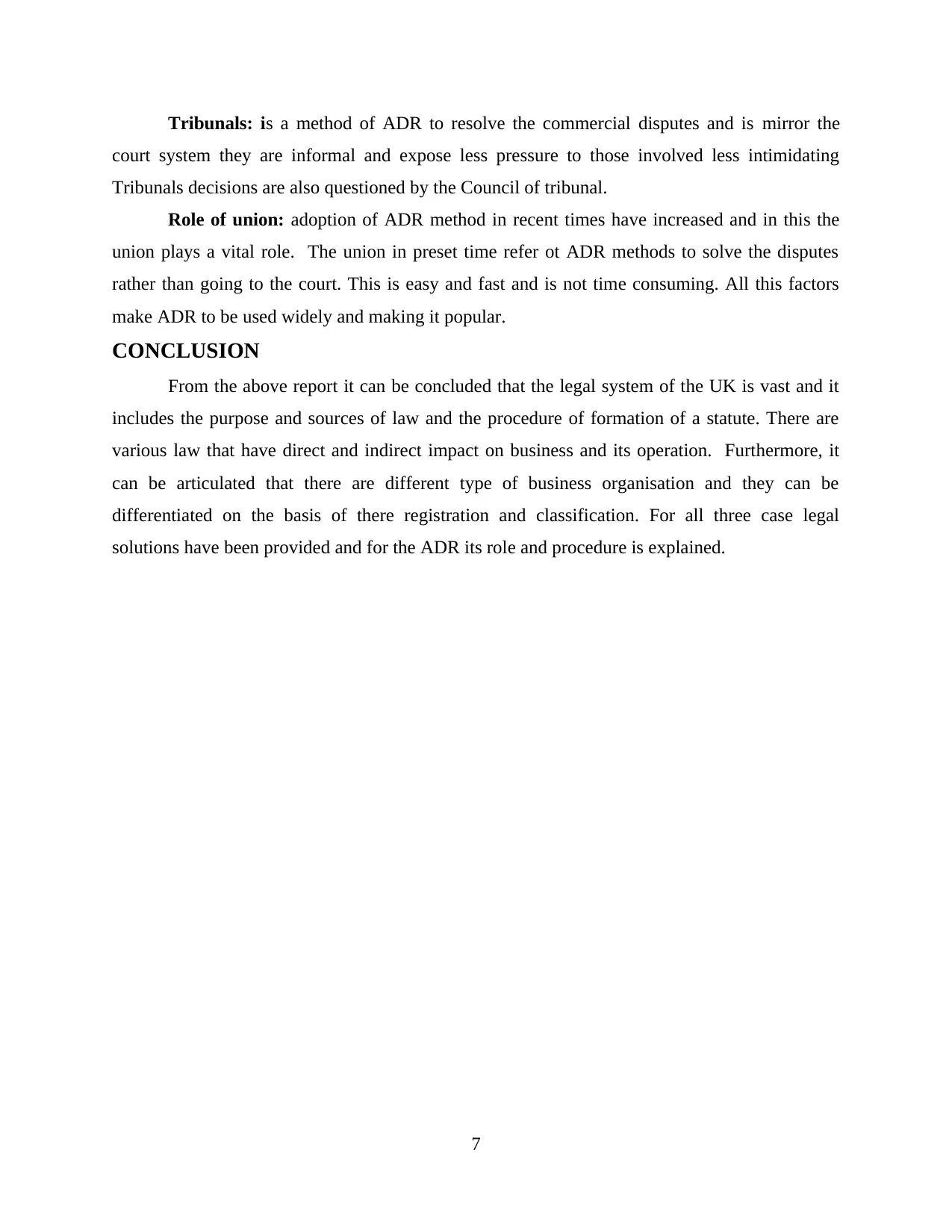
Tribunals: is a method of ADR to resolve the commercial disputes and is mirror the
court system they are informal and expose less pressure to those involved less intimidating
Tribunals decisions are also questioned by the Council of tribunal.
Role of union: adoption of ADR method in recent times have increased and in this the
union plays a vital role. The union in preset time refer ot ADR methods to solve the disputes
rather than going to the court. This is easy and fast and is not time consuming. All this factors
make ADR to be used widely and making it popular.
CONCLUSION
From the above report it can be concluded that the legal system of the UK is vast and it
includes the purpose and sources of law and the procedure of formation of a statute. There are
various law that have direct and indirect impact on business and its operation. Furthermore, it
can be articulated that there are different type of business organisation and they can be
differentiated on the basis of there registration and classification. For all three case legal
solutions have been provided and for the ADR its role and procedure is explained.
7
court system they are informal and expose less pressure to those involved less intimidating
Tribunals decisions are also questioned by the Council of tribunal.
Role of union: adoption of ADR method in recent times have increased and in this the
union plays a vital role. The union in preset time refer ot ADR methods to solve the disputes
rather than going to the court. This is easy and fast and is not time consuming. All this factors
make ADR to be used widely and making it popular.
CONCLUSION
From the above report it can be concluded that the legal system of the UK is vast and it
includes the purpose and sources of law and the procedure of formation of a statute. There are
various law that have direct and indirect impact on business and its operation. Furthermore, it
can be articulated that there are different type of business organisation and they can be
differentiated on the basis of there registration and classification. For all three case legal
solutions have been provided and for the ADR its role and procedure is explained.
7
⊘ This is a preview!⊘
Do you want full access?
Subscribe today to unlock all pages.

Trusted by 1+ million students worldwide
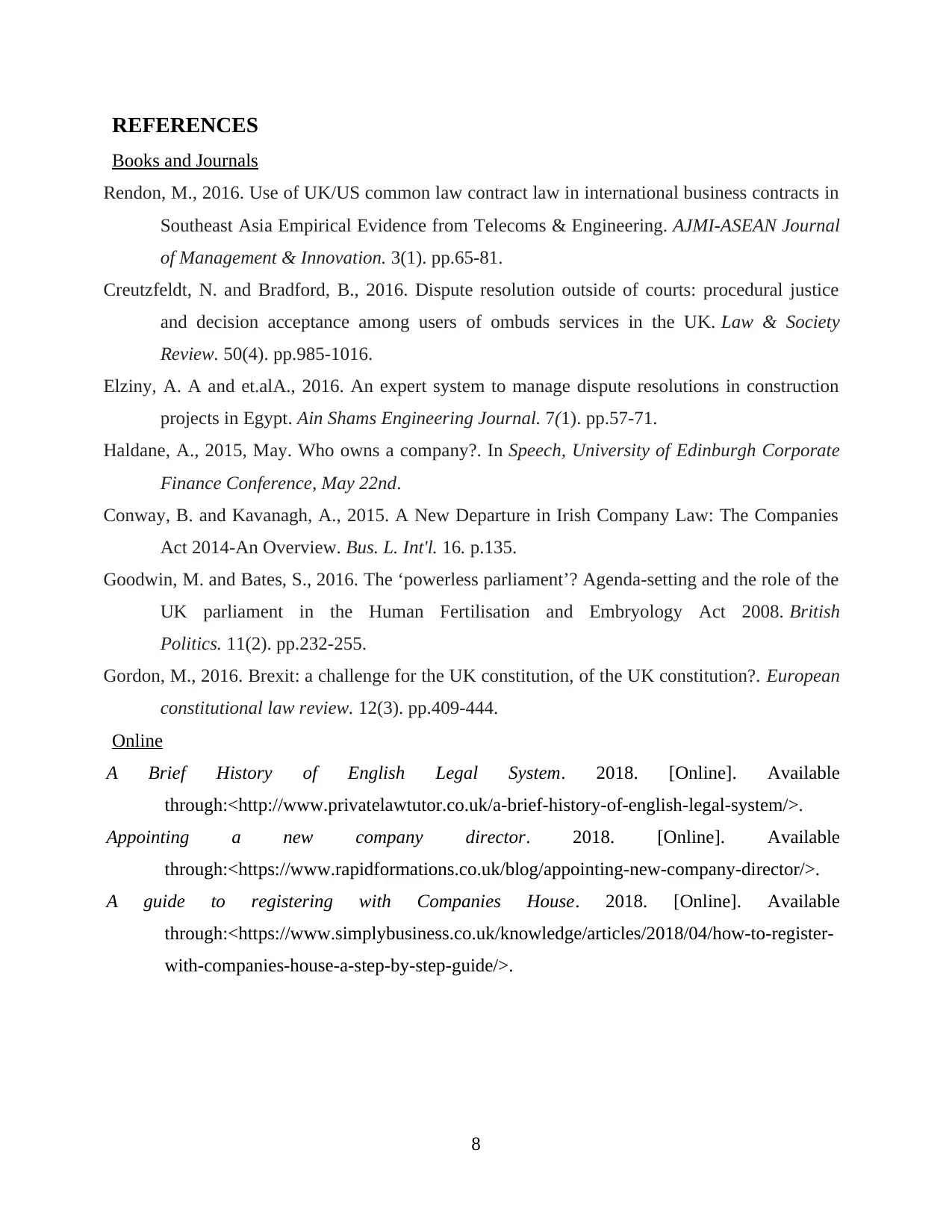
REFERENCES
Books and Journals
Rendon, M., 2016. Use of UK/US common law contract law in international business contracts in
Southeast Asia Empirical Evidence from Telecoms & Engineering. AJMI-ASEAN Journal
of Management & Innovation. 3(1). pp.65-81.
Creutzfeldt, N. and Bradford, B., 2016. Dispute resolution outside of courts: procedural justice
and decision acceptance among users of ombuds services in the UK. Law & Society
Review. 50(4). pp.985-1016.
Elziny, A. A and et.alA., 2016. An expert system to manage dispute resolutions in construction
projects in Egypt. Ain Shams Engineering Journal. 7(1). pp.57-71.
Haldane, A., 2015, May. Who owns a company?. In Speech, University of Edinburgh Corporate
Finance Conference, May 22nd.
Conway, B. and Kavanagh, A., 2015. A New Departure in Irish Company Law: The Companies
Act 2014-An Overview. Bus. L. Int'l. 16. p.135.
Goodwin, M. and Bates, S., 2016. The ‘powerless parliament’? Agenda-setting and the role of the
UK parliament in the Human Fertilisation and Embryology Act 2008. British
Politics. 11(2). pp.232-255.
Gordon, M., 2016. Brexit: a challenge for the UK constitution, of the UK constitution?. European
constitutional law review. 12(3). pp.409-444.
Online
A Brief History of English Legal System. 2018. [Online]. Available
through:<http://www.privatelawtutor.co.uk/a-brief-history-of-english-legal-system/>.
Appointing a new company director. 2018. [Online]. Available
through:<https://www.rapidformations.co.uk/blog/appointing-new-company-director/>.
A guide to registering with Companies House. 2018. [Online]. Available
through:<https://www.simplybusiness.co.uk/knowledge/articles/2018/04/how-to-register-
with-companies-house-a-step-by-step-guide/>.
8
Books and Journals
Rendon, M., 2016. Use of UK/US common law contract law in international business contracts in
Southeast Asia Empirical Evidence from Telecoms & Engineering. AJMI-ASEAN Journal
of Management & Innovation. 3(1). pp.65-81.
Creutzfeldt, N. and Bradford, B., 2016. Dispute resolution outside of courts: procedural justice
and decision acceptance among users of ombuds services in the UK. Law & Society
Review. 50(4). pp.985-1016.
Elziny, A. A and et.alA., 2016. An expert system to manage dispute resolutions in construction
projects in Egypt. Ain Shams Engineering Journal. 7(1). pp.57-71.
Haldane, A., 2015, May. Who owns a company?. In Speech, University of Edinburgh Corporate
Finance Conference, May 22nd.
Conway, B. and Kavanagh, A., 2015. A New Departure in Irish Company Law: The Companies
Act 2014-An Overview. Bus. L. Int'l. 16. p.135.
Goodwin, M. and Bates, S., 2016. The ‘powerless parliament’? Agenda-setting and the role of the
UK parliament in the Human Fertilisation and Embryology Act 2008. British
Politics. 11(2). pp.232-255.
Gordon, M., 2016. Brexit: a challenge for the UK constitution, of the UK constitution?. European
constitutional law review. 12(3). pp.409-444.
Online
A Brief History of English Legal System. 2018. [Online]. Available
through:<http://www.privatelawtutor.co.uk/a-brief-history-of-english-legal-system/>.
Appointing a new company director. 2018. [Online]. Available
through:<https://www.rapidformations.co.uk/blog/appointing-new-company-director/>.
A guide to registering with Companies House. 2018. [Online]. Available
through:<https://www.simplybusiness.co.uk/knowledge/articles/2018/04/how-to-register-
with-companies-house-a-step-by-step-guide/>.
8
1 out of 10
Related Documents
Your All-in-One AI-Powered Toolkit for Academic Success.
+13062052269
info@desklib.com
Available 24*7 on WhatsApp / Email
![[object Object]](/_next/static/media/star-bottom.7253800d.svg)
Unlock your academic potential
Copyright © 2020–2025 A2Z Services. All Rights Reserved. Developed and managed by ZUCOL.





